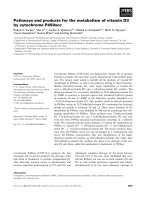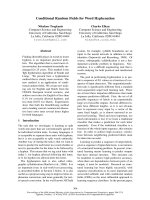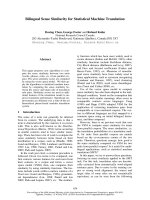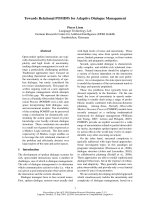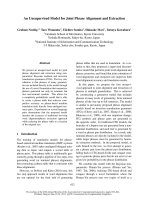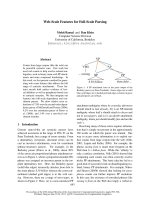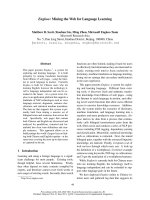Báo cáo khoa học: "Simultaneous in-field boost for patients with 1 to 4 brain metastasis/es treated with volumetric modulated arc therapy: a prospective study on quality-of-life" potx
Bạn đang xem bản rút gọn của tài liệu. Xem và tải ngay bản đầy đủ của tài liệu tại đây (444.16 KB, 8 trang )
RESEARCH Open Access
Simultaneous in-field boost for patients with 1 to
4 brain metastasis/es treated with volumetric
modulated arc therapy: a prospective study on
quality-of-life
Damien C Weber
1,2*
, Francesca Caparrotti
1
, Mohamed Laouiti
1
and Karim Malek
1
Abstract
Purpose: To assess treatment toxicity and patients’ survival/quality of life (QoL) after volumetric modulated arc
therapy (VMAT) with simultaneous in-field boost (SIB) for cancer patients with 1 - 4 brain metastases (BM) treated
with or without surgery.
Methods and Materials: Between March and December 2010, 29 BM patients (total volume BM, < 40 cm
3
) aged
< 80 years, KPS ≥ 70, RPA < III were included in this prospective trial. Whole brain VMAT (30 Gy) and a SIB to the
BM (40 Gy) was delivered in 10 fraction. Mean age was 62.1 ± 8.5 years. Fifteen (51.7%) underwent surgery. KPS
and MMSE were prospectively assessed. A self-assessed questionnaire was used to assess the QoL (EORTC QLQ-C30
with -BN20 module).
Results: As of April 2011 and after a mean FU of 5.4 ± 2.8 months, 14 (48.3%) patients died. The 6-month overall
survival was 55.1%. Alopecia was only observed in 9 (31%) patients. In 3-month survivors, KPS was significantly (p =
0.01) decreased. MMSE score remained however stable (p = 0.33). Overall, QoL did decrease after VMAT. The mean
QLQ-C30 global health status (p = 0.72) and emotional functional (p = 0.91) scores were decreased (low QoL).
Physical (p = 0.05) and role functioning score (p = 0.01) were significantly worse and rapidly decreased during
treatment. The majority of BN20 domains and single items worsened 3 months after VMAT except headaches (p =
0.046) and bladder control (p = 0.26) which improved.
Conclusions: The delivery of 40 Gy in 10 fractions to 1 - 4 BM using VMAT was achieved with no significant
toxicity. QoL, performance status, but not MMSE, was however compromised 3 months after treatment in this
selected cohort of BM patients.
Introduction
Brain metastases (BMs) occur in 25 to 45% of all cancer
patients and repr esent thus a significant clinical problem
in cancer management [1]. Whole brain radiation therapy
(WBRT) with steroids is usually t he primary treatment
option for patients with multiple BMs. Patients with 1 - 4
BMs are routinely treated with surgery and/or radiosur-
gery, with or without WBRT. After these treatments,
local and distant brain failure is however a clinic al issue
and occurs in a substan tial number of patients. Two pro-
spective phase III trial have shown a 1-year local and/or
brain failure rate of 30% - 100% [2,3].
Improvement of local control of BM may not necessa-
rily lead to improved survival but is of paramount impor-
tance to maintain neurological function and may be a
worthwhile objective, especially in subsets of patients
with a better prognosis. Treatment failure has been
showntohaveanimpactonpatient’ s neurocognitive
function [4] and possib ly quality of life ( QoL) [5]. As
such, selected subgroups of patients (i.e. younger age,
good performance status, controlled primary tumor,
absence of extracranial disease and/or limited number of
* Correspondence:
1
Radiation Oncology Department, Département de l’Imagerie Médical et
Science de l’Information (DIMSI), Geneva University Hospital/University of
Geneva, CH-1211 Geneva 14, Switzerland
Full list of author information is available at the end of the article
Weber et al . Radiation Oncology 2011, 6:79
/>© 2011 Webe r et al; licensee BioMed Central Ltd. This is an Open Access article distributed under the terms of the Creative Commons
Attribution License ( which permits unrestricted use, distribution, and reproduction in
any medium, provided the original work is properly cited.
BM) might benefit from dose e scalation [2,6] although
this strategy is historically controversia l [7,8]. Any dose
escalation paradigm may translate however in increased
radiation-induced toxicit y and may have a deleterious
effect on neurocognitive function and/or QoL. Two stu-
dies assessed the QoL in patients with prima ry brain
tumors and BMs [9,10], but no study has studied pro-
spectively this end-point specifically for BM’spatients
treated with a dose-escalation paradi gm. Cons eque ntly,
we embarked in a prospective study assessing the toxi-
city, neurocognitive function and QoL of good prognostic
patients with 1 - 4 BM treated with a dose escalation
strategy using a volumetric modulated arc therapy tech-
nique (VMAT).
Patients and methods
Patients and Treatment characteristics
From March 2010 to December 2010, 29 patients with
previously untreated brain metastasis were included into
an institutional prospective protocol of WBRT with SIB to
single or multiple BMs. Patient eligibility for this trial was
as follows: histologically proven cancer; brain MRI consis-
tent with BM(s); 1 to 4 BMs; age < 80 years; Karnofsky
performance status (KPS) ≥ 70; RPA < III; total volume of
BM ≤ 40 ml and no previous cranial RT. The presence of
extracranial disease was allowed. Patients were allowed to
undergo craniotomy. Quality -of-life (QoL) was evaluated
prospectively using the QLQ-C30 and -BN20 instruments
developed by the European Organization for Research and
Treatment of Cancer (EORTC). The primary end-point of
this study was QoL. The secondary endpoints were toxi-
city, overall survival (OS) and brain progression-free survi-
val (PFS). The characteristics of the patients are detailed in
Table 1.
The gross tumor volume (GTV) was defined as the BM
and/or the surgical resection cavity. The planning target
volume (PTV) was obtained by adding a 3 mm margin to
the GTV. In ass ociation with WBRT, a SIB was adminis-
tered to all brain lesions. A composite VMAT plan was
gen erated for all patients, consisting of WBRT ( 30 Gy in
10 fractions) with a SIB of 10 Gy in 10 fractions to the
PTVs. The cumulative dose delivered to the BM(s) was
thus 40 Gy in 10 fractions. The treatment plans were gen-
erated using a volumetric modulated arc therapy (VMAT)
technique, all computed on the Varian Eclipse treatment
planning system with 6 MV photon beams from a Varian
Clinac equipped with a Millennium Multileaf Collimator
(MLC; Novalis Tx, BrainLab, Feldkirchen, Germany) with
120 leaves. Plans were optimized selecting a maximum
dose rate of 600 MU/min. Two modulated arcs were used
for all patients. Mean UM delivered was 671 ± 142.
Patients were treated using a thermoplastic immobili-
zation mask used during simulation, with positioning
determined by co-registration of the simulation kV CT
scan with a MVCT scan acquired on the treatment unit.
Quality-of-life questionnaires and administration
QoL in this study was assessed with the EORTC QLQ-
C30 (version 3.0) and-QLQ-BN20. The self-administered
QLQ-C30 is the EORTC core QoL questionnaire that
addresses a range of functional outcomes and symptoms
relevant to a wide range of cancer populations [11]. This
30-item questionnaire is composed of both multi-item
scales and single-item measures. It is composed of a glo-
bal health status (GHS) scale (2 items), functional scales
(15 items) and symptom scales/items (13 items). Func-
tional scales consist of physical (PF), role (RF), emotional
(EF), cognitive and social functioning scales. Each item is
scored from 1 to 4 (’’not at all’’:1;‘’a little’’:2;‘’quite a
Table 1 Patient’s characteristics (n = 29)
n%
Gender
Male 16 55.2
Female 13 44.8
Age (Years)
Median 62.3 (range, 42-78.3)
Mean 62.1 ± 8.5
RPA
I 6 20.7
II 23 79.3
GPA
0 - 1 3 10.3
1.5 - 2.5 21 72.5
3 3 10.3
3.5 - 4 2 6.9
Primary Tumor
Lung 22 76.0
Breast 3 10.3
Melanoma 1 3.4
Other 3 10.3
Number of BM
1 13 44.8
2 - 3 9 30.1
4 7 24.1
Surgery 15 51.7
Concomitant chemotherapy 10 34.5
Abbreviations : RPA, Recursive Partitioning Analysis; GPA, Graded Prognosis
Assesment; BM, Brain Metastasis.
Weber et al . Radiation Oncology 2011, 6:79
/>Page 2 of 8
bit’’:3;“very much’’: 4). As an exception, GHS is scored
from 1 (‘‘very poor’’)to7(‘‘excellent’’). Raw scores (RS)
were obtained by calculating the average of all item com-
ponents. Item range is the difference between the maxi-
mum and minimum response to an individual i tem. The
core calculation is detailed in the Appendix. A higher
score for the GHS and functio nal scales represent thus a
higher QoL and high level of functioning, respectively.
Conversely,ahighscoreforasymptomscalerepresents
a high level of symptomatology.
The self-administered QoL questionnaire BN20 consists
of 4 multi-items scale that assesses: future uncertainty
(4 items), visual disorder (3 items), motor dysfunction
(3 items) and communication deficit (3 items) [12]. Addi-
tionally, symptoms are addressed by single items: head-
aches, hair loss, weakness of legs and bladder control. The
scoring algorithm for the scales is similar to the scoring of
the EORTC-C30 questionnaire. RS are computed and line-
arly transformed to a 0 - 100 scale. For the scales and
items, a higher score represents worse QoL. Details of the
in-field testing of the BN20 in a multi-national and multi-
lingual setting have been published previously [13].
The QoL assessment took place during the first con-
sultation in the radiation oncology department, during
VMAT (week 1 & 2) and every 3 months after the end
of VMAT until tumor progression. All QLQ-C30 and
-BN20 scores were prospectively collected into an insti-
tutional electronic database.
Performance status and neurocognitive function
Performance status was assessed using the standard KPS
scale [14]. Neurocognitive function was assessed using
the MMSE dementia-scale [15], which has b een shown
to be a survival prognosticator in BM patients [16]. The
baseline and follow-up evaluation of the KPS and
MMSE was perfo rmed by t he same attending radiation
oncologist before the start of treatment, during and
after VMAT.
Radiation-induce toxicity
Alopecia was were classified ac cording t o t he National Can -
cer Institute Common T erminolo gy Criteria for Adverse
Events (CTCAE) v3.0 grading system cer.
gov/search/search.asp?zoom_query = CTCAE&Action =
Go%3E, except for skin toxicity which was scored using the
Radiation Therapy Oncology Group (RTOG) scoring sys-
tem />tReporting/CooperativeGroupCommonToxicityCriteria.
aspx. Toxicity assessment was made during VMAT (week 1
& 2) and every 3 months after t he end of VMAT.
Statistical analysis
OS and PFS were calculated using the Kaplan Meier
method [17]. Recorded events w ere death (all causes of
death included) and local and distant brain failure for
OS and PFS, respectively. Survival differences between
subgroups were evaluated using the log-rank test (p
value < 0.05 was considered statistically significant).
QoL results are presented as mean scores with standard
deviations and were compared between time points
using the Wilcoxon rank sum test and a p value < 0.05
was considered statistically significant. All analyses were
performed using the SPSS statistical package (SPSS 17.0,
Chicago, IL).
Results
Patients’ outcome and prognostic factors
After a mean FU of 5.4 ± 2.8 months, 14 (48.3%)
patients died. The 6-month OS was 55.1%. Patient
undergoing surgery survived significantly longer than
those not undergoing surgery: the estimated 6-month
OS was 72.0% vs. 33.5%, respectively (p = 0.035). Like-
wise, patients with good performance status lived signifi-
cantly longer. The estimated 6-month OS was 66.9%
and 37.5% for patients with a KPS of 9 0-100 and 70-80,
respectively (p = 0.025). Motor dysfunction (p = 0.11),
emotional functioning (EF; p = 0.25), role functioning
(RF; p = 0.27), future uncertainty (p = 0.35), global
health status (GHS; p = 0.38), MMSE (p = 0.40), visual
deficit (p = 0.59), number of BM (p = 0.64), age (p =
0.66), communication deficit (p = 0.79), gender (p =
0.80) and physical functionin g (PF; p =0.85)werehow-
ever not prognostic for OS in this study.
Overall, 6 treatment failures were observed. Three
(13.0%) patients presented with local f ailure but distant
brain control and another 3 (13.0%) presented with local
control but distant brain failure. The estimated 6-
months brain PFS was 77.9%. Overall, 23 (79.4%)
patients were controlled locally and distantly in the
brain. The majority (n = 17 out of 23 tumour progres-
sion; 74.0%) presented with progressive extra-cranial
systemic disease. Toxicity was minimal. No radiation-
induced erythema was obser ved. Grade CTCAE 1 and 2
alopecia was only observed in 9 (31.0%) patients.
QoL and neurocognitive function
MMSE, KPS and self-assessed QoL were compared dur-
ing VMAT. Nineteen (65.5%) patients completed all
questionnaires before and during VMAT (week 1 and
2). The reasons fo r not completing the questionnaires in
the other 10 (34.5%) patients were as follow: a ccidental
destruction of the QoL questionnaires by the adminis-
trative team in 5 patients, deterioration of cognitive
function or performance status preventing com pleting
of the questionnaires in 2 patients, non compliance in
que stionnaire administration by physicians in 2 patients
and patient refusal in 1 patients. During VMAT, the
performance status decreased although not significantly
Weber et al . Radiation Oncology 2011, 6:79
/>Page 3 of 8
so. Mean KPS before and during VMAT was 89.4 ± 11.6
and 85.3 ± 18.1, respectively (p > 0.1). MMSE signifi-
cantly improved however during VMAT. Mean MMSE
scores were 27.1 ± 2.7 and 28.1 ± 2.5 (p = 0.04). During
VMAT, GHS remained stable (Figure 1; Table 2). For
the C30 functional scale, a statistical trend was observed
fordecreasingPFduringVMAT(Figure1;Table2).EF
remained fairly stable during VMAT (Figure 1; Table 2).
RF was however significantly decreased during VMAT
(Figure 1; Table 2). Table 2 details the domain’s and sin-
gle item’ s scores of the BN20 questionnaire during
VMAT. Headaches were significantly decreased d uring
VMAT. Mean headache-BN20 observed scores were
37.0 ± 41.0 and 18.5 ± 23.5 before and during VMAT,
respectively (p = 0.048; Table 2). A statistical trend was
observed for future uncertainty, which decreased during
VMAT (Table 2; p = 0.07). Communication deficit also
decreased during VMAT, although no statistical trend
was observed (Table 2; p = 0.13). Intere stingly, hair loss
issues was reported less often during VMAT (Table 2;
p = 0.11).
MMSE, KPS and self-assessed QoL were also com-
pared for the time points before and 3 months after the
start of VMAT. Fourteen (77.8%) patients completed
questionnaires at both time points. The re ason for not
completing the questionnaires in the other 4 (22.2%)
patients was death within 3 months after VMAT in all
patients. Among the patients completing the question-
naire, 4 (28.6%) presented with systemic progressive dis-
ease. Three brain failures (21.4%) were observed. At
3-months follow-up, patients had a significantly worse
performance status. Mean KPS scores were 9 2.1 ± 8.0
and 82.1 ± 15.8 before and after VMAT, respectively
(p = 0.01). MMSE score were however stable. Mean
MMSE scores were 27.3 ± 2.4 and 27.4 ± 4.2 before and
3 months after VMAT, respectively (p = 0.33). GHS
remained fairly stable (Figure 2; Table 3). For PF, a sta-
tistical trend was observed for decreasing values after
VMAT (Figure 2; Table 3). EF remained also stable after
VMAT (Figure 2; Table 3). RF was however significantly
decreased (Figure 2; Table 3).
Table 3 details the domain’ s and single item’sscores
of the BN20 questionnaire. Except for headache and
bladder control sco res, all other scores worsened 3
months after VMAT. As mentioned, headaches were
significantly decreased after VMAT. Mean headache-
BN20 observed score s were 3 3.3 ± 37.0 and 7.1 ± 14.2
before and 3 months after VMAT, respectively (p =
0.046; Table 3). Interestingly, hair loss was reported
more often 3 months after VMAT, altho ugh not signifi-
cantly so. Mean hair loss-BN20 observed scores were
14.3 ± 31.2 and 23.8 ± 30.5 before and 3 months after
VMAT, respectively (p = 0.48; Table 3).
MMSE, KPS and self-assessed QoL were also com-
pared for the time points before and 6 months after the
start of VMAT. Five (17.2%) patients completed ques-
tionnaires at both time points. All other patients with
complete C30 and BN20 data did not reach this time
point. In these patients, no local or distant brain failure
was observed. One patient presented with progressive
extra-cranial systemic disease. Mean KPS scores were
94.0 ± 5.5 and 90 ± 14.1 before and 6 months after
VMAT, respectively (p = 0.41). Mean MMSE scores
were 27.0 ± 2.4 and 27.8 ± 2.9 before and 6 months
after VMAT, respectively (p = 0.18). EORTC-C30 scores
remained stable (Table 4). Tab le 4 also details the
domain’s and single item’s scores of the BN20 question-
naire. All but communication deficit domains were non-
significantly worse at 6 months (Table 4).
Discussion
Tothebestofourknowledge,thepresentstudyisthe
first series ever published on a prospective evaluation of
QoL in patients with BM, not including primary brain
tumors, treated with VMAT and dose escalation. The
efforts at developing new therapeutic strategies in BM
should not only focus on increasing survivorship but
should also assess their relative impact on QoL. Dose
escalation may be potentially neuroto xic and thus nega-
tively affect health-relate d QoL in these BM patients. As
such, we embarked in a careful prospective evaluation of
QoL in a pilot VMAT dose escalation protocol. Our
data suggests several comments. First, QoL assessment
was indeed difficult in this patient cohort, even though
*
*p=0.05
**
p
=0.02
*
**
During VMAT
Figure 1 Self-assessed QoL (EORTC-C30) before and during
VMAT for Global Health Status, and physical, emotional and
role functioning.
Weber et al . Radiation Oncology 2011, 6:79
/>Page 4 of 8
a dedicated physician was assigned to do the QoL
assessment. The difficulty in assessing QoL or neurocog-
nitive function in patients with BM has been reported
by other investigators [5,14]. Only one patient out of
two could be assessed at the 3 months post-VMAT time
point, as a result of decreasing performance status and/
or cognitive function, administrative issues or patient
refusal. Second, the overall QoL of these patients did
indeed decrease 3 months after VMAT as reported by
other authors [18](Table 3). In order to avoid any
potential bias originating from the death of patients
with poor-QoL, the comparison of QoL at the two time
points (i.e. baseline and at 3 months) was performed
using only data from patients completing questionnaires
at both time points [ 19]. Additionally, performance sta-
tus did also significantly decrease, but the neurocogni-
tive function, assessed with the MMSE, appeared to be
stable in this small cohort. Interestingly, the levels of
three EORTC-BN20 domains, namely visual disorder,
motor dysfunction and communication deficit, remained
stable at this time point, suggesting a possible a ssocia-
tion between MMSE and these scores, as reported by
other authors [13]. Third, except for physical and role
functioning (Figure 1), the observed QoL did not sub-
stantially decrease during treatment. MMSE significantly
increased during treatment, possibly as a result of the
therapeutic effect of radiation. Although one third of
patients experienced alopecia, the EORTC-BN20 mean
score for this item was decreased (Table 2), suggesting
that there is not necessarily agreement between patient
and physician reports of symptoms or toxicity [20,21].
Some EORTC-BN20 domains were even improved dur-
ing VMAT (Table 2), with an observed statistical trend
for future uncertainty levels, which may reflect the effec-
tiveness of coping strategies. Finally, lower functional
and GHS scores in the EORTC-C30 questionnaire and
higher EORTC-BN20 domain’sscoreswereassociated
with decreased survival suggesting that these scores may
be relevant prognosticators for BMs [18]. Although no
statistical trend was observed, possibly as a result of
smal l numbers, all Kaplan-Meier curves were parallel to
Table 2 EORTC-C30 and -BN20 domain and single item’s scores before and during VMAT
QoL Pre-VMAT score ± SD Score during VMAT ± SD p value
C30
Global Health Status 62.5 ± 26.4 62.0 ± 21.4 0.92
Physical functioning 78.9 ± 22.9 65.1 ± 31.2 0.05
Emotional functioning 74.8 ± 20.1 74.3 ± 27.0 0.86
Role functioning 75.0 ± 21.6 55.5 ± 37.1 0.02
BN20 domains/items
Domains
Future uncertainty 30.8 ± 20.9 18.8 ± 23.5 0.07
Visual disorder 13.6 ± 20.7 13.3 ± 17.4 0.92
Motor dysfunction 22.5 ± 24.1 22.2 ± 26.9 0.64
Communication deficit 19.7 ± 28.1 13.6 ± 16.8 0.13
Single items
Headache 37.0 ± 41.0 18.5 ± 23.5 < 0.05
Hair loss 14.8 ± 30.7 3.7 ± 15.7 0.11
Weakness of legs 24.1 ± 29.8 25.9 ± 31.4 0.58
Bladder control 16.7 ± 30.8 14.8 ± 28.5 0.79
Abbreviations: QoL: Quality of life; SD, standard devi ation.
AfterVMAT
*
**
* p=0.05
**p=0.01
Figure 2 Self-assessed QoL (EOR TC-C30) before and 3 months
after VMAT for Global Health Status, and physical, emotional
and role functioning.
Weber et al . Radiation Oncology 2011, 6:79
/>Page 5 of 8
what was expected, i.e. worse QoL was related to
decreased survivorship (data not sho wn). Using tradi-
tional method of statistical analysis (i.e. Cox multivariate
model) controlled for major clinical prognostic factors,
some EORTC-C30 or -BN20 items, such as cognitive
function or GHS, have been significantly associated with
survival in two prospective trials [22,23], although these
results are controversial [9,24,25]. The mechanisms
underlying these potential associations are however
unclear. QoL scores may reflect the patient’sphysical
and psychological state that may have a positive effect
on the overall disease process (i.e. higher QoL score are
a proxy for the patient’s health status that may have a
positive effect on the underlying disease). Alternatively
to this true causative relationship, these scores may
reveal the early perception and severity of the disease
more accurately than conventional prognostic indices
(i.e. lower QoL score reflect a worse underlying disease).
Table 3 EORTC-C30 and -BN20 domain and single item’s scores before and 3 months after VMAT
QoL Pre-VMAT scoren ± SD Score during VMAT ± SD p value
C30
Global Health Status 65.4 ± 22.8 60.1 ± 26.6 0.72
Physical functioning 81.4 ± 17.6 63.3 ± 29.8 0.05
Emotional functioning 77.7 ± 21.2 74.4 ± 26.2 0.91
Role functioning 72.6 ± 22.3 45.2 ± 37.8 0.01
BN20 domains/items
Domains
Future uncertainty 27.1 ± 20.7 27.4 ± 31.6 0.66
Visual disorder 12.7 ± 21.3 15.1 ± 21.2 0.25
Motor dysfunction 21.4 ± 24.8 22.2 ± 33.5 0.96
Communication deficit 23.0 ± 30.3 27.8 ± 29.5 0.55
Single items
Headache 33.3 ± 37.0 7.1 ± 14.2 < 0.05
Hair loss 14.3 ± 31.2 23.8 ± 30.5 0.48
Weakness of legs 21.4 ± 24.8 28.6 ± 34.2 0.39
Bladder control 21.4 ± 33.6 11.9 ± 24.8 0.26
Abbreviations: QoL: Quality of life; SD, standard devi ation.
Table 4 EORTC-C30 and -BN20 domain and single item’s scores before and 6 months after VMAT
QoL Pre-VMAT score ± SD Score during VMAT ± SD p value
C30
Global Health Status 62.5 ± 26.4 68.8 ± 20.8 0.47
Physical functioning 78.9 ± 22.9.6 71.9 ± 26.0 0.72
Emotional functioning 74.8 ± 20.1 70.0 ± 41.5 0.89
Role functioning 75.0 ± 21.6 73.3 ± 41.8 0.72
BN20 domains/items
Domains
Future uncertainty 26.0 ± 23.5 30.0 ± 41.5 0.72
Visual disorder 15.5 ± 12.7 28.9 ± 36.5 0.41
Motor dysfunction 15.5 ± 16.8 24.4 ± 30.8 0.59
Communication deficit 22.2 ± 28.3 6.6 ± 6.1 0.29
Single items
Headache 26.7 ± 43.5 20.0 ± 29.8 0.99
Hair loss 13.3 ± 29.8 0.0 ± 0.0 0.32
Weakness of legs 20.0 ± 18.2 26.6 ± 27.9 0.66
Bladder control 0.0 ± 0.0 0.0 ± 0.0 1.00
Abbreviations: QoL: Quality of life; SD, standard devi ation.
Weber et al . Radiation Oncology 2011, 6:79
/>Page 6 of 8
Of note, several issues, such a s the in tercorrelation of
the QoL parameters or the high variability in survival in
patients with identical QoL scores to name a few, have
bee n raised by the use of classical methods of statistical
computation [23]. Further research regarding the prog-
nostic value of health-related QoL is justified in the fra-
mework of future prospective trials.
We sought to investigate whether a hypofractionated
SIB approach for the treatment of patients with 1 - 4
BMs would be a safe alternati ve to WBRT with or with-
out radiosurgery. The observed toxicity was minimal.
Less than one third of patients had alopecia at the end
of treatment. These results may be in keeping with
recent phase I dose escalation studies reporting the toxi-
city in patients treated with WBRT and an SIB techni-
que [26,27]. In the US study, alopecia and skin react ion
were reported in 16% and 6% of patients, respectively
[26]. The reduction of the observed alopecia rates, when
compared to those observed with WBRT, may have an
impact on the patient’ s QoL, as assessed by the
EORTC-BN20 questionnaire (Table 4).
The treatment of patients with BM can consist of best
supportive care, surgery or radiosurgery with or without
WBRT. We have included patients with one BM in our
treatment protocol as the modulation of the WBRT by a
VMAT approach may produce steeper radiation-dose
gradients than plans with conventional WBRT summed
with radiosu rgery dose deposition [28]. For pati ents with
good- to intermediate-prognosis (i.e. RPA I - II), such a s
those treated in our protocol, a multi-modality treatment
strategy is usually proposed with the aim of preventing
intracranial pr ogress ion, pres erving the neurologic func-
tion and possibly the overall QoL. In our study, local and
distant brain tumor control was achieved in a majority of
patients. Unfortunately, systemic extracranial progression
was observed in a majority (74.0%) of patients with a con-
sequential impact on survivorship. Interestingly, the esti-
mated 6-months OS was significantly increased (72% vs.
33.5%) when surgery was performed to patients with 1 -
4 BM. These results should be interpreted cautiously, as
they may be subject to uncontrolled patient selection
into different treatment groups (i.e. better KPS and RPA/
GPA scores for patients undergoing surgery). They are
however in line with several prospective studies confirm-
ing the importance of surgery in selected patients [29,30].
Although we did not perform a multivariate analysis as
the number of events relative to the potential parameters
was inappropriate, these data suggest that dose escalation
only with a SIB technique may not be the optimal treat-
ment for these good- to intermediate-prognosis patients.
There were several limitations of our study. First, the
small sample size of 29 patients limited the statistical
power to assess fully the QoL of BM patients treated
with VMAT and to detect associations between survival
and the EORTC-C30 and -BN20 parameters. Second,
the rate of completion of the questionnaires in these
severely ill patients, although identical to the compliance
rate reported in the literature, was suboptimal. High
compliance in questionnaire completion is d ifficult to
achieve in severely ill patients as their condition deterio-
rates over time. Third, as the number of brain p rogres-
sions was low, the impact of this event on patient’s QoL
at the 3 months time point was not assessable. This
being said, this study was a prospective study with speci-
fic QoL endpoints and the BM patient cohort studied
was homogeneous and represented a good- to inter-
mediate-prognosis population fo r whom the QoL is of
paramount importance.
In summary, the delivery of 40 Gy in 10 fractions
using a VMAT technique was achieved with no signifi-
cant toxicity. The majority of patients presented with
extracranial progressive disease. Surgery and perfor-
mance status were significant prognostic factors for sur-
vival. Although the QoL did not decrease significantly
during treatment, a decrease of several EORTC-C30 and
-BN20 parameters was observed at 3 months after
VMAT.
Additional material
Additional file 1: Appendix. Equations for functional scale, GHS and
symptom scales/items scores.
Abbreviations
GPA: Graded Prognostic Assessment; BM: brain metastasis; KPS: Karnofsky
performance status; RPA: recursive partitioning analysis; RTOG: Radiation
Therapy Oncology Group; CTCAE: National Cancer Institute Common
Terminology Criteria for Adverse Events; VMAT: volumetric modulated arc
therapy; QoL: Quality of Life; WBRT: Whole brain radiotherapy; EORTC:
European Organization for research and Treatment of Cancer; MMSE: Mini
Mental State Examination; GHS: Global Health Status; PF: Physical
functioning; EF: Emotional functioning; RF: Role functioning.
Author details
1
Radiation Oncology Department, Département de l’Imagerie Médical et
Science de l’Information (DIMSI), Geneva University Hospital/University of
Geneva, CH-1211 Geneva 14, Switzerland.
2
University of Geneva, CH-1211
Geneva, Switzerland.
Authors’ contributions
DCW was responsible for the primary concept and the design of the study;
FC, ML, KM and DCW, performed the data capture and analysis. FC and
DCW drafted the manuscript; DCW performed the statistical analysis; FC and
DCW reviewed patient data; all authors revised the manuscript. All authors
have read and approved the final manuscript.
Competing interests
The authors declare that they have no competing interests.
Received: 2 May 2011 Accepted: 30 June 2011 Published: 30 June 2011
References
1. Nussbaum ES, Djalilian HR, Cho KH, Hall WA: Brain metastases. Histology,
multiplicity, surgery, and survival. Cancer 1996, 78(8):1781-8.
Weber et al . Radiation Oncology 2011, 6:79
/>Page 7 of 8
2. Andrews DW, Scott CB, Sperduto PW, Flanders AE, Gaspar LE, Schell MC,
et al: Whole brain radiation therapy with or without stereotactic
radiosurgery boost for patients with one to three brain metastases:
phase III results of the RTOG 9508 randomised trial. Lancet 2004,
363(9422):1665-72.
3. Kondziolka D, Patel A, Lunsford LD, Kassam A, Flickinger JC: Stereotactic
radiosurgery plus whole brain radiotherapy versus radiotherapy alone
for patients with multiple brain metastases. International journal of
radiation oncology, biology, physics 1999, 45(2):427-34.
4. Meyers CA, Smith JA, Bezjak A, Mehta MP, Liebmann J, Illidge T, et al:
Neurocognitive function and progression in patients with brain
metastases treated with whole-brain radiation and motexafin
gadolinium: results of a randomized phase III trial. J Clin Oncol 2004,
22(1):157-65.
5. Li J, Bentzen SM, Li J, Renschler M, Mehta MP: Relationship between
neurocognitive function and quality of life after whole-brain
radiotherapy in patients with brain metastasis. International journal of
radiation oncology, biology, physics 2008, 71(1):64-70.
6. Casanova N, Mazouni Z, Bieri S, Combescure C, Pica A, Weber DC: Whole
brain radiotherapy with a conformational external beam radiation boost
for lung cancer patients with 1-3 brain metastasis: a multi institutional
study. Radiat Oncol 2010, 5:13.
7. Harwood AR, Simson WJ: Radiation therapy of cerebral metastases: a
randomized prospective clinical trial. International journal of radiation
oncology, biology, physics 1977, 2(11-12):1091-4.
8. Borgelt B, Gelber R, Kramer S, Brady LW, Chang CH, Davis LW, et al: The
palliation of brain metastases: final results of the first two studies by the
Radiation Therapy Oncology Group. International journal of radiation
oncology, biology, physics 6(1):1-9.
9. Sehlen S, Lenk M, Hollenhorst H, Schymura B, Aydemir U, Herschbach P,
et al: Quality of life (QoL) as predictive mediator variable for survival in
patients with intracerebral neoplasma during radiotherapy. Onkologie
2003, 26(1):38-43.
10. Regine WF, Schmitt FA, Scott CB, Dearth C, Patchell RA, Nichols RC Jr, et al:
Feasibility of neurocognitive outcome evaluations in patients with brain
metastases in a multi-institutional cooperative group setting: results of
Radiation Therapy Oncology Group trial BR-0018. International journal of
radiation oncology, biology, physics 2004, 58(5):1346-52.
11. Aaronson NK, Ahmedzai S, Bergman B, Bullinger M, Cull A, Duez NJ, et al:
The European Organization for Research and Treatment of Cancer QLQ-
C30: a quality-of-life instrument for use in international clinical trials in
oncology. J Natl Cancer Inst 1993, 85(5):365-76.
12. Osoba D, Aaronson NK, Muller M, Sneeuw K, Hsu MA, Yung WK, et al: The
development and psychometric validation of a brain cancer quality-of-
life questionnaire for use in combination with general cancer-specific
questionnaires. Qual Life Res 1996, 5(1):139-50.
13. Taphoorn MJ, Claassens L, Aaronson NK, Coens C, Mauer M, Osoba D, et al:
An international validation study of the EORTC brain cancer module
(EORTC QLQ-BN20) for assessing health-related quality of life and
symptoms in brain cancer patients. Eur J Cancer 2010,
46(6):1033-40.
14. Komosinska K, Kepka L, Niwinska A, Pietrzak L, Wierzchowski M, Tyc-
Szczepaniak D, et al: Prospective evaluation of the palliative effect of
whole-brain radiotherapy in patients with brain metastases and poor
performance status. Acta oncologica (Stockholm, Sweden) 2010, 49(3):382-8.
15. Folstein MF, Folstein SE, McHugh PR: “Mini-mental state”. A practical
method for grading the cognitive state of patients for the clinician.
J Psychiatr Res 1975, 12(3):189-98.
16. Murray KJ, Scott C, Zachariah B, Michalski JM, Demas W, Vora NL, et al:
Importance of the mini-mental status examination in the treatment of
patients with brain metastases: a report from the Radiation Therapy
Oncology Group protocol 91-04. International journal of radiation oncology,
biology, physics 2000, 48(1):59-64.
17. Kaplan E, Meier P: Nonparametric estimation for incomplete observations.
J Am Stat Assoc 53:458-481.
18. Steinmann D, Schafer C, van Oorschot B, Wypior HJ, Bruns F, Bolling T, et al:
Effects of radiotherapy for brain metastases on quality of life (QoL).
Prospective pilot study of the DEGRO QoL working party. Strahlenther
Onkol 2009, 185(3):190-7.
19. Vordermark D: Avoiding bias in the prospective evaluation of patients
with brain metastases. J Clin Oncol 2007, 25(25):4023, author reply 4024-5.
20. Fromme EK, Eilers KM, Mori M, Hsieh YC, Beer TM: How accurate is
clinician reporting of chemotherapy adverse effects? A comparison with
patient-reported symptoms from the Quality-of-Life Questionnaire C30.
J Clin Oncol 22(17):3485-90.
21. Basch E, Iasonos A, McDonough T, Barz A, Culkin A, Kris MG, et al: Patient
versus clinician symptom reporting using the National Cancer Institute
Common Terminology Criteria for Adverse Events: results of a
questionnaire-based study. Lancet Oncol 2006, 7(11):903-9.
22. Mauer M, Stupp R, Taphoorn MJ, Coens C, Osoba D, Marosi C, et al: The
prognostic value of health-related quality-of-life data in predicting
survival in glioblastoma cancer patients: results from an international
randomised phase III EORTC Brain Tumour and Radiation Oncology
Groups, and NCIC Clinical Trials Group study. British journal of cancer
2007, 97(3):302-7.
23. Mauer ME, Taphoorn MJ, Bottomley A, Coens C, Efficace F, Sanson M, et al:
Prognostic value of health-related quality-of-life data in predicting
survival in patients with anaplastic oligodendrogliomas, from a phase III
EORTC brain cancer group study. J Clin Oncol 2007, 25(36):5731-7.
24. Meyers CA, Hess KR, Yung WK, Levin VA: Cognitive function as a predictor
of survival in patients with recurrent malignant glioma. J Clin Oncol
18(3):646-50.
25. Klein M, Postma TJ, Taphoorn MJ, Aaronson NK, Vandertop WP, Muller M,
et al: The prognostic value of cognitive functioning in the survival of
patients with high-grade glioma. Neurology 2003, 61(12)
:1796-8.
26. Rodrigues G, Yartsev S, Yaremko B, Perera F, Dar AR, Hammond A, et al:
Phase I Trial of Simultaneous In-Field Boost With Helical Tomotherapy
for Patients With One to Three Brain Metastases. International journal of
radiation oncology, biology, physics 2010.
27. Bauman G, Yartsev S, Fisher B, Kron T, Laperriere N, Heydarian M, et al:
Simultaneous infield boost with helical tomotherapy for patients with 1
to 3 brain metastases. American journal of clinical oncology 2007,
30(1):38-44.
28. Lagerwaard FJ, van der Hoorn EA, Verbakel WF, Haasbeek CJ, Slotman BJ,
Senan S: Whole-brain radiotherapy with simultaneous integrated boost
to multiple brain metastases using volumetric modulated arc therapy.
International journal of radiation oncology, biology, physics 2009, 75(1):253-9.
29. Patchell RA, Tibbs PA, Walsh JW, Dempsey RJ, Maruyama Y, Kryscio RJ, et al :
A randomized trial of surgery in the treatment of single metastases to
the brain. The New England journal of medicine 1990, 322(8):494-500.
30. Noordijk EM, Vecht CJ, Haaxma-Reiche H, Padberg GW, Voormolen JH,
Hoekstra FH, et al: The choice of treatment of single brain metastasis
should be based on extracranial tumor activity and age. International
journal of radiation oncology, biology, physics 1994, 29(4):711-7.
doi:10.1186/1748-717X-6-79
Cite this article as: Weber et al.: Simultaneous in-field boost for patients
with 1 to 4 brain metastasis/es treated with volumetric modulated arc
therapy: a prospective study on quality-of-life. Radiation Oncology 2011
6:79.
Submit your next manuscript to BioMed Central
and take full advantage of:
• Convenient online submission
• Thorough peer review
• No space constraints or color figure charges
• Immediate publication on acceptance
• Inclusion in PubMed, CAS, Scopus and Google Scholar
• Research which is freely available for redistribution
Submit your manuscript at
www.biomedcentral.com/submit
Weber et al . Radiation Oncology 2011, 6:79
/>Page 8 of 8
